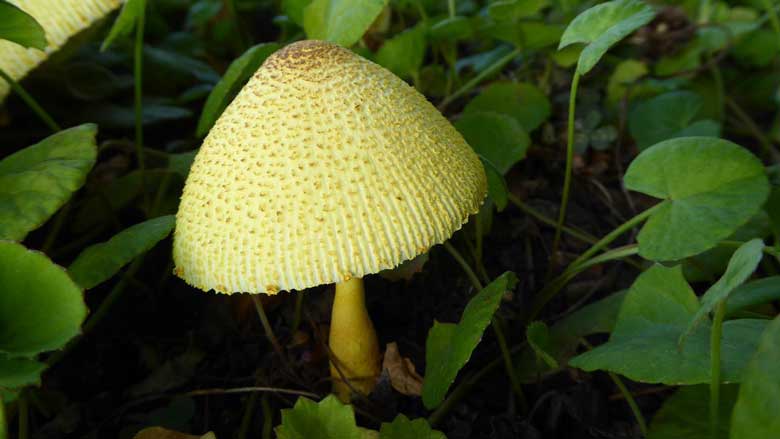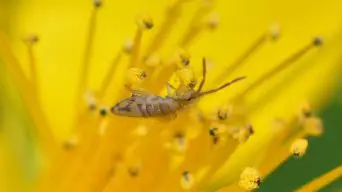Growing houseplants is a great way to add life and color to your home.
But sometimes, mushrooms can start growing in your houseplant soil.
Mushrooms in houseplants can be a real problem.
Here you’ll learn how to get rid of mushrooms in houseplants and prevent them from coming back.
Why Do Mushrooms Grow in Houseplants?
Mushrooms are a type of fungi.
They typically grow in moist, shady areas. Houseplants provide the perfect environment for mushrooms to grow.
The soil is often moist and humid, and there is little light.
Mushrooms release spores into the air. These spores can land on your houseplant soil and start to grow.
Mushrooms are often found in potted plants because the conditions are ideal for them to grow: dark, moist, and humid.
Also, adding new potting mix or bark to your plants can bring in mushroom spore from outside.
Once the spores land on your houseplant soil, they start to grow.
Types of Mushrooms That Grow in Houseplants
Many different types of mushrooms can grow in houseplants.
You can often find them growing near the base of your potted plant or on the surface of the soil.
The most common type of mushroom that grows in houseplants is the Leucocoprinus birnbaumii, also known as Lepiota lutea.
This mushroom is often called the “flower pot” because it’s usually found growing in potted plants.
It’s a small, yellow mushroom with tiny scales on the surface.
This common mushroom is often found in warm, humid climates.
Another type of mushroom that can grow in houseplants is the Coprinus comatus, also known as the “shaggy mane” mushroom.
This mushroom is often found growing on lawns. It has a white cap with shaggy scales.
The gills of this mushroom are white when they’re young, but they turn black as they mature.
This mushroom is often found in temperate climates.
Are Mushrooms Bad for Houseplants?
Mushrooms are not necessarily bad for your houseplants.
Some houseplant mushrooms can actually be beneficial for your plants.
Mushrooms help to break down organic matter in the soil.
This helps to improve the soil quality and makes it easier for roots to absorb nutrients.
Mushrooms also produce enzymes that help to decompose organic material.
This can release essential nutrients into the soil, such as nitrogen, phosphorus, and potassium.
Should You Remove Mushrooms From Potted Plants?
Although mushrooms are not bad for your indoor plants, they can be a problem if they start to take over.
A mushroom infestation can quickly become out of control and can be challenging to get rid of.
Mushrooms can also be a problem if you have small children or pets.
Some mushrooms are toxic if they’re ingested.
If you have small children or pets, it’s essential to remove mushrooms from your houseplants as soon as you see them.
How to Get Rid of Mushrooms in Houseplants
Getting rid of mushrooms in your houseplants is not easy.
Once the fungus and spores that cause mushrooms to grow are in your potting soil mix, it isn’t easy to get rid of them.
However, you can do a few things to get rid of mushrooms in your houseplants.
1. Remove the Mushrooms by Hand
The easiest way to get rid of mushrooms is to remove them by hand.
Be sure to wear gloves when you’re handling them so you don’t get spores on your hands and spread them to other areas of your home.
Use a small shovel or trowel to remove the mushrooms and a few inches of the potting mix around them.
Once you’ve removed the mushrooms, put them in a plastic bag and throw them away.
2. Change the Potting Soil
If you have a severe mushroom problem, you may need to change the soil of your houplants.
Remove all of the old potting soil mix from your pots and replace it with new fresh soil.
This will help to get rid of any spores that are in the old potting mix.
3. Improve Air Circulation
Mushrooms need dark, humid conditions to grow.
One way to discourage mushrooms from growing is to improve air circulation around your plants.
Make sure your plants are not too close together, and there is adequate airflow around them.
You can also increase air circulation by running a fan near your plants.
4. Reduce Humidity
Mushrooms thrive in humid conditions.
To discourage mushrooms from growing, you can try to reduce the humidity around your plants.
Ensure your plants are not near a water source, such as a sink or a shower.
You can also use a dehumidifier to reduce the humidity in your home.
5. Treat With Fungicide
If you have a serious mushroom problem, you may need to treat your plants with a fungicide.
Fungicides are chemicals that kill fungi.
There are a variety of fungicides available, so be sure to choose one that’s specifically designed to kill mushrooms.
Follow the directions on the label carefully and take care not to get the fungicide on your skin or your eyes.
You may need to treat your plants with a fungicide more than once to eliminate the mushrooms.
6. Dispose of Infected Plants
If you can’t get rid of mushrooms in your houseplants, you may need to dispose of the infected plants.
Mushrooms can spread quickly and can be challenging to control.
If you have a severe infestation, it’s best to get rid of the affected plants.
Be sure to dispose of them in a plastic bag, so the spores don’t spread.
To be safe, you may also want to consider disposing of the potting mix.
How To Stop Mushrooms From Growing in Potted Plants
The best way to stop mushrooms from growing in your potted plants is to prevent them from getting started in the first place.
Here are a few tips to help you do that:
1. Use Sterile Potting Mix
When potting your plants, be sure to use a sterile potting mix.
This will help to prevent fungi and spores from getting into your potting mix.
2. Don’t Overwater
Mushrooms need moist conditions to grow.
Don’t overwater them to prevent them from growing in your potted plants.
Allow the potting mix to dry out between watering.
3. Remove Dead Leaves and Debris
Another way to prevent mushrooms from growing in your potted plants is to remove dead leaves and debris.
Fungi and spores can grow on dead leaves and debris, so removing them from your potting mix is important.
4. Avoid Crowding
When you’re potting your plants, avoid crowding them.
Crowded conditions can create the perfect environment for fungi and spores to grow.
5. Provide Good Drainage
To prevent mushrooms from growing in your potted plants, provide good drainage.
Mushrooms need moist conditions to grow, so they will often grow in pots that don’t have good drainage.
To provide good drainage, use a potting mix that contains perlite or vermiculite.
6. Place Your Potted Plants in a Bright Location
Mushrooms need darkness to grow.
To prevent them from growing in your potted plants, place them in a bright location where they will get plenty of sunlight.
7. Inspect Your Potted Plants Regularly
Inspect your potted plants regularly for mushrooms.
If you see any mushrooms growing, remove them immediately.
Mushrooms can spread quickly, so removing them as soon as you see them is essential.
Final Thoughts
Mushrooms growing in houseplant soil are a common problem in indoor and outdoor plants.
Mushrooms are a type of fungus, and they generally appear after a period of heavy rain or wet weather.
While they may look unsightly, mushrooms are not harmful to your plants and can actually be beneficial as they help decompose organic matter.
If you don’t like the look of mushrooms in your houseplants, there are a few things you can do to get rid of them.
However, it’s important to note that it’s not an easy task. Mushrooms reproduce by releasing spores into the air.
These spores can then land on your houseplants and start new colonies of mushrooms.
The best approach to treat and prevent mushrooms from developing in your houseplants is to avoid offering the conditions they require to grow.
This includes reducing moisture and increasing air circulation.
If you have a problem with mushrooms, take action right away as they can quickly take over your plants.
Thanks for reading!







